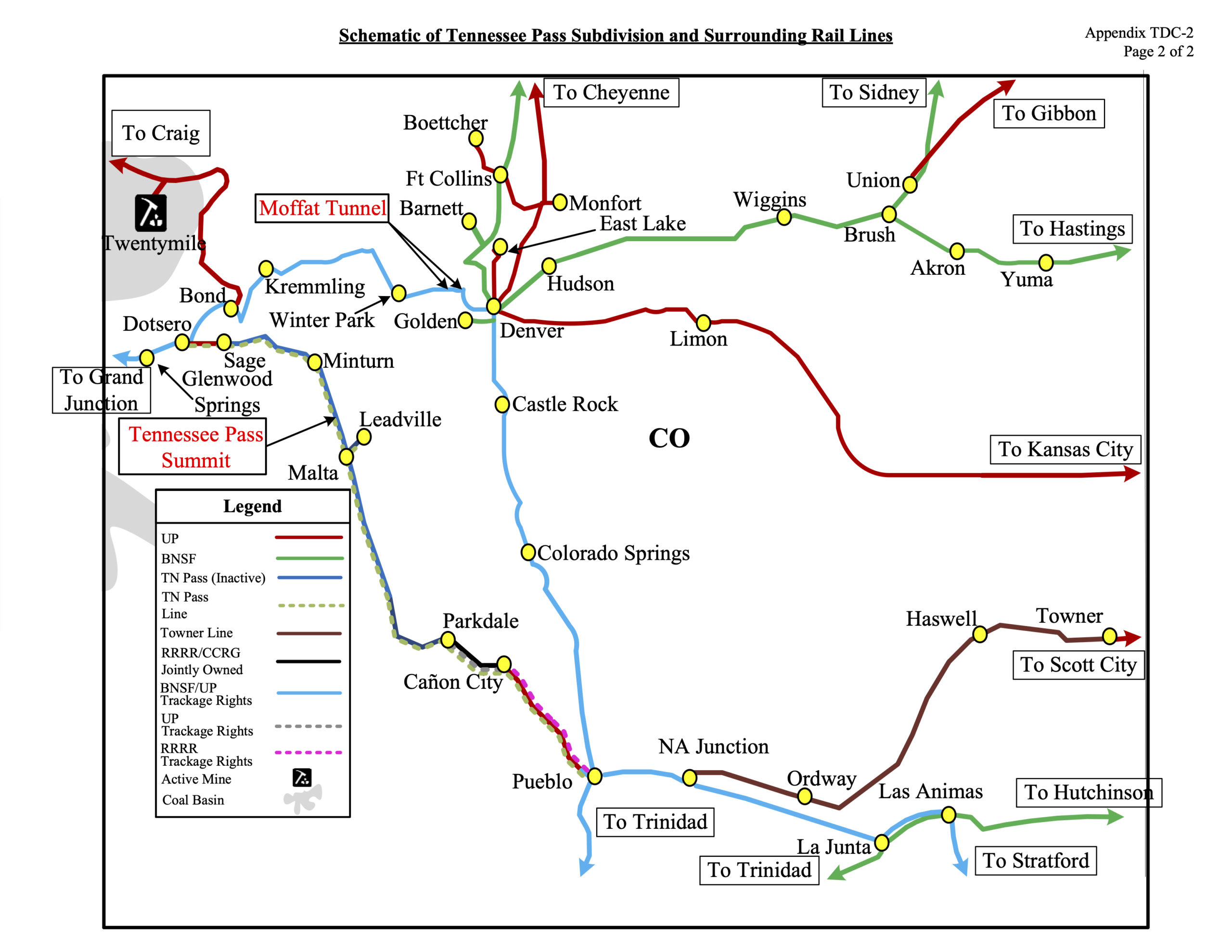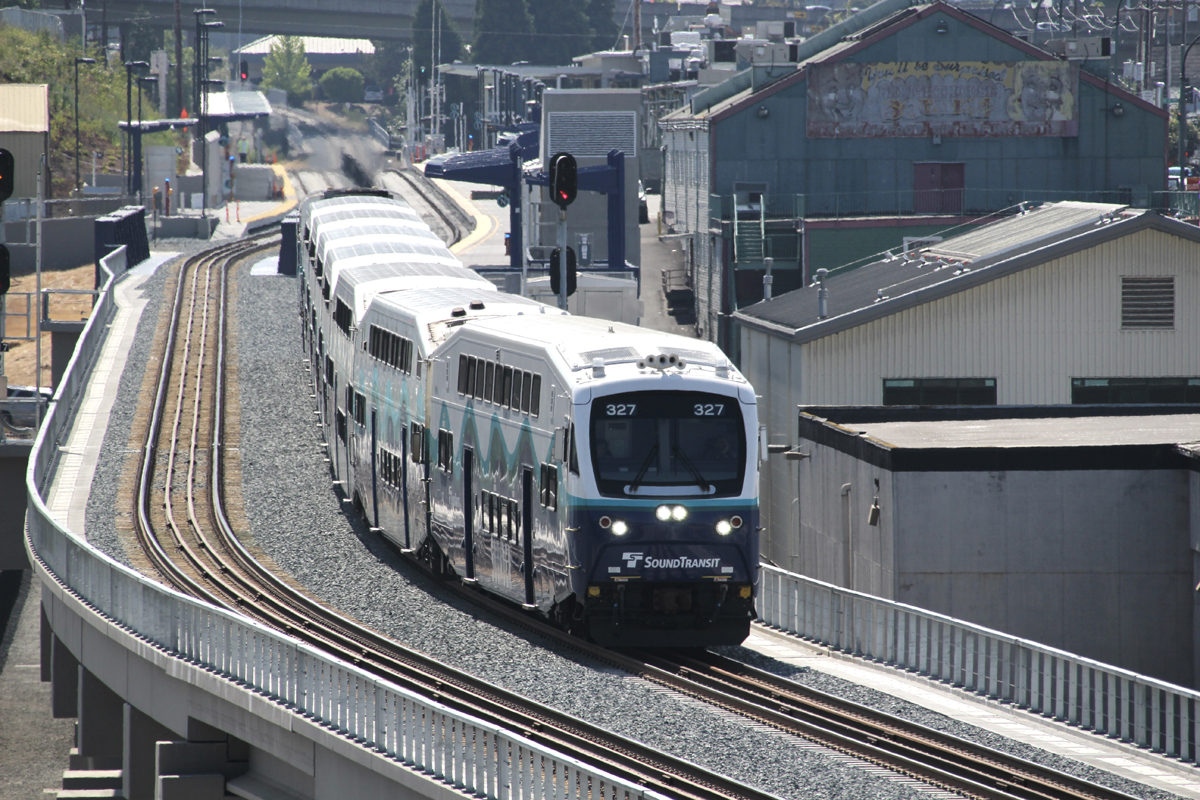KCVN LLC and its subsidiary, Colorado Pacific Railroad LLC, last week said they would buy the long-dormant route for its liquidation value of $8.8 million, down from a $10 million offer they made to Union Pacific in November.
UP in December declined Colorado Pacific’s offer and said it was in active discussions with other parties to restore service on the line.
But KCVN and Colorado Pacific say they could find no evidence that UP was talking with potential line suitors. So, they filed a feeder line application to gain control of the route. It’s the same maneuver they used in 2018 to acquire and resuscitate the 121.9-mile Towner Line in eastern Colorado.
The sale of the Tennessee Pass line to Colorado Pacific would create a nearly 400-mile route extending from Towner, Colo., to Dotsero, Colo., that would provide grain and mining shippers with a shortcut to Utah and the West Coast, KCVN says in its filing.
Colorado Pacific would spend $278 million to bring the Tennessee Pass route back to Federal Railroad Administration Class 2 track standards that would permit 25 mph operation.
KCVN last year spent $3.5 million to restore the Towner Line to FRA Class 2 track standards and in April expects to begin service on the line, with Watco’s Kansas and Oklahoma as the designated operator.
UP says it continues to work with another potential operator for the Tennessee Pass route.
“We are aware of the complaint; however, we are in active discussions with another party to potentially restore service to the line, and we plan to continue those discussions,” a UP spokeswoman says.
KCVN is controlled by New York real estate developer Sheldon Solow and his son, Stefan Soloviev, who reverted to the traditional spelling of the family’s name.
Soloviev, who controls Colorado Pacific, has extensive land holdings in the West totaling more than 350,000 acres, including cropland in Colorado, Kansas, and New Mexico. His companies, which operate under the name Crossroads Agriculture, own grain elevators in eastern Colorado and western Kansas.
“If they want to move grain west, either to flour mills at Salt Lake City/Ogden or Los Angeles, or for export from Pacific Northwest points along the Columbia River in Washington, the wheat must first move 250 miles east to Hutchinson, Kansas, and then be placed on another westbound UP line, along which it travels 250 miles back west just to reach the State of Colorado again, having traveled 500 miles without any net westward progress,” William Osborn wrote in Colorado Pacific’s regulatory filing.
Efforts to move grain westward are stymied by the 500-mile detour and the long-closed gateway at NA Junction, where the Towner Line meets the UP-BNSF Railway Joint Line 26 miles east of Pueblo, Colorado.
Karyn A. Booth, an attorney who heads the transportation practice at Thompson Hine in Washington, says feeder line applications fall somewhere between rare and routine.
“They are not an everyday occurrence,” she says.
Feeder line applicants must demonstrate that:
• A sale is required by “the public convenience and necessity.”
• The current owner has no interest in providing service over the line.
• Current service is inadequate.
• The sale of a line will not have an adverse financial effect on the current owner.
• The sale will improve service.
Tennessee Pass, with its 3% grade, was one of two main lines the Denver & Rio Grande Western maintained over the Continental Divide. UP took over the combined Rio Grande-Southern Pacific system in 1996 and a year later ceased regular service over the pass.
The east end of the railroad, from Pueblo to Parkdale, was later sold to a short line, Rock & Rail, but UP maintains trackage rights. The Royal Gorge Route Railroad also operates excursions out of Cañon City. Both would remain in place under Colorado Pacific’s plans.















Corr. -That’s 6000 ft of gain from Pueblo to Tennessee pass, not a trivial climb.
So, what’s the best guess about a competing entity that wants to rebuild the line with 100 year old bridges & rotting RR ties? Then they would be moving trains up 8000 ft. from Pueblo, next, brake down steep grade to Minturn, instead of using existing UP / BNSF trackage? Hard to see savings on this rigerous route to cover rehab costs? KCVN may be in over its head with the Towner line, much less a steep mountain line?
Any guess at the train traffic on Towner, if it were to start in April?
Sheldon Solow and his son Stefan Soloviev could build an all-new 21-mile rail line between Eads and Kit Carson that could link the ex-MP line with the Kansas Pacific. That would eliminate the circuitous routing of the westward grain shipments and would probably be a lot cheaper than their current proposal. They’d still have to deal with UP however.
UP will not necessarily give the Colorado Pacific the best rates to haul from Dotsero to export at Oakland after an adversarial takeover of the Tennessee Pass route.
However, BNSF could get that Colorado Pacific grain to tidewater in Oakland with its trackage rights.
So it might not be such a far-fetched proposition. Time will tell.
Am I mistaken or is the legend in the enclosed map incorrect?
The legend names UP the blue line and BNSF the red lines.
To my opinion this should be reversed. Or does BNSF really own the line from Denver to Grand Junction?
The line from Denver to Grand Junction is owned by UP (D&RGW) with BNSF trackage rights. The map line is light blue and matches the legend “BNSF/UP Trackage Rights”.
Back in 2003, UPRR telecom dept sent me as a telecom tech. to an OSHA required snow cat safety survival school that was being held at a motel in Leadville. While driving from Pueblo to Leadville along that seemingly abandoned Tennessee Pass Arkansas River line, as an experienced E-L Rwy/Conrail open wire pole Iine maintaner from PA & NJ, I couldn’t help noticing the the 4 pair, 600 ohm, open wire telecom trunk pole line that was being kept and maintained in impeccable condition. I haven’t been up there since 2003, but if that open wire line is still there, does anyone know who had/has been maintaining and operating that open wire pole line. And was it now being used for high speed data?
A few years ago, my wife and I traveled toward the Royal Gorge from the west where the highway parallels this line. At that time, there was a huge number of gondola-type cars stored on the line. If that’s still the case, I wonder who owns them and how they go about dispersing these surplus cars elsewhere.
If the Colorado Southwest wants good service, it should become a majority stockholder of the UP. Get new management that wants more business. Right now the railroads could care less about new business.
Jeffrey Pletcher, If they in consultation with the operators of the K&O, then yeas, they are talking with the right people. K&O is a WATCO operation, which operate several mountain railroads.
The Minturn Yard is still there although weed-grown. Several roads have paved over the tracks. The old Minturn station is actually still there as well, although boarded up.
In response to Mr. Christmas’ post, UP owns the Moffatt line and BNSF has trackage rights over it (which it obtained in teh UP-SP merger).
@Jeffrey Marker,
The map lists Moffat as “BNSF/UP Trackage Rights” which would seem to suggest that BNSF owns it, and UP has trackage rights, when in fact the arrangement is the other way around.
Altogether not a very good graphic when it comes to clarifying who owns and operates what in the area.
If they are serious about moving grain to the west coast, they should offer to buy the Raton Pass line from the BNSF, rather than trust a cantankerous UP to move their freight from Dotsero on west.
The last thing you want is to have WATCO as as railroad partner. They don’t know whether to scratch their watch or wind their ass.
Google Earth mage of Sept 2019 shows that the Minturn yard is still there. However the $8.8 million offer for the line is ludicrous, since the yard real estate itself is probably worth that much to Vail Resorts who would like to build another ski base there.
Thanks for the “Colo. Eagle” reminder…it is always good to think about what was there.
And, I wonder if the “New York real estate magnates” are consulting with the right people regarding the high costs associated with restoring and operating this mountain railroad?
Looks like a simpler, cheaper solution to the circuitous shipping issue is to restore the connection at NA and route the Towner Line traffic west to Pueblo, then up the Joint Line to Denver, from which traffic could move west or wherever. They’d have to negotiate trackage rights or something with the J. L. operators, so they might not have as much control over operations as with their own Tennessee Pass routing. Looks like they will have to negotiate some agreement anyway for handling traffic west of Dotsero.
By the way, the “Towner Line” is former Missouri Pacific main line trackage, route of the “Colorado Eagle.”
John Bedell,
If the UP is negotiating with another party to operate the line you can bet those negotiations are bound by an NDA and no one can talk about it, which is why that’s the only statement you got from the UP. They’re contractually bound not to name the interested party, only that they’re talking to someone.
Mr Westgate, if memory serves me correctly there is still yard trackage in Minturn. I believe any yard in Salida is gone, but the land is still there. Most if not all the copper wiring for signals is gone. There have also been several rock slides in the Belden-Pando area. Tracks there have been damaged by the slides and have been told some of the rocks are as large if not bigger than a house.
A decade ago there was still a yard at Minturn. It must still be there.
So, who are the “other parties” or the “other potential operators” with whom UP claims to be in discussions?
UP officials from Omaha were scared to death when they saw tennesee pass for the first time.
So, I’m curious…. If I remember correctly, there used to be a yard facility somewhere along the line, I believe at Minturn. Is it, or the open land, still there? Would it be needed? What’s the plan, hand off the train to UP or BNSF at Dotsero? Would they change power there? Or use one of them and assign essentially dedicated power to take the train to Provo/SLC/Ogden? Helper operations? Or would they use DP on the train and size the power/braking/dynamic braking requirements according to Tennessee Pass, and to a lesser degree, Soldier Summit? The latter assumes there would be a run thru or trackage rights agreement of some sort.